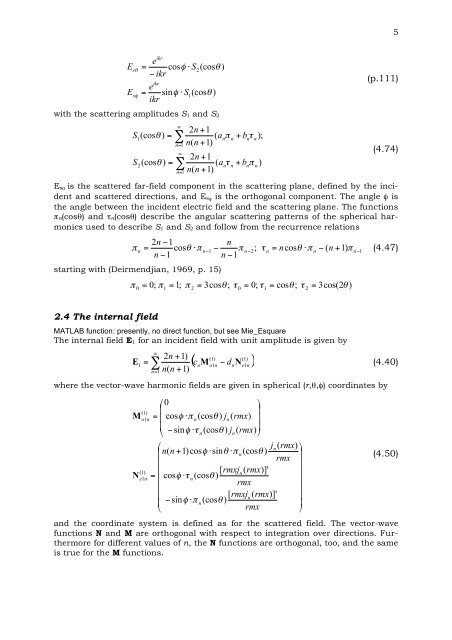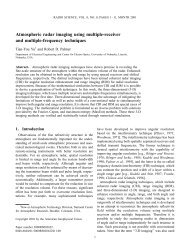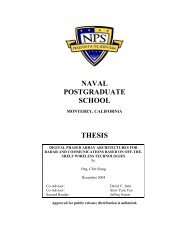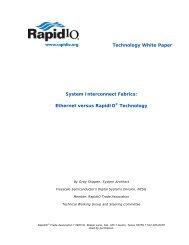MATLAB Functions for Mie Scattering and Absorption
MATLAB Functions for Mie Scattering and Absorption
MATLAB Functions for Mie Scattering and Absorption
Create successful ePaper yourself
Turn your PDF publications into a flip-book with our unique Google optimized e-Paper software.
5<br />
E<br />
E<br />
s!<br />
s"<br />
ikr<br />
e<br />
= cos"<br />
# S2(cos!<br />
)<br />
$ ikr<br />
ikr<br />
e<br />
= sin"<br />
# S1(cos!<br />
)<br />
ikr<br />
with the scattering amplitudes S 1 <strong>and</strong> S 2<br />
S (cos%<br />
) =<br />
1<br />
S (cos%<br />
) =<br />
2<br />
"<br />
!<br />
n=<br />
1<br />
"<br />
!<br />
n=<br />
1<br />
2n<br />
+ 1<br />
( an#<br />
n<br />
n(<br />
n + 1)<br />
2n<br />
+ 1<br />
( an$<br />
n<br />
n(<br />
n + 1)<br />
+ b $ );<br />
n<br />
+ b # )<br />
n<br />
n<br />
n<br />
(p.111)<br />
(4.74)<br />
E s θ is the scattered far-field component in the scattering plane, defined by the incident<br />
<strong>and</strong> scattered directions, <strong>and</strong> E s φ is the orthogonal component. The angle φ is<br />
the angle between the incident electric field <strong>and</strong> the scattering plane. The functions<br />
π n(cosθ) <strong>and</strong> τ n(cosθ) describe the angular scattering patterns of the spherical harmonics<br />
used to describe S 1 <strong>and</strong> S 2 <strong>and</strong> follow from the recurrence relations<br />
2n<br />
! 1<br />
n<br />
#<br />
n<br />
= cos$<br />
"#<br />
n! 1<br />
! #<br />
n!<br />
2;<br />
%<br />
n<br />
= ncos$<br />
"#<br />
n<br />
! ( n + 1)<br />
#<br />
n!<br />
1<br />
(4.47)<br />
n ! 1<br />
n ! 1<br />
starting with (Deirmendjian, 1969, p. 15)<br />
#<br />
0<br />
= 0;<br />
#<br />
1<br />
= 1; #<br />
2<br />
= 3cos!<br />
; "<br />
0<br />
= 0; "<br />
1<br />
= cos!<br />
; "<br />
2<br />
= 3cos(2!<br />
)<br />
2.4 The internal field<br />
<strong>MATLAB</strong> function: presently, no direct function, but see <strong>Mie</strong>_Esquare<br />
The internal field E 1 <strong>for</strong> an incident field with unit amplitude is given by<br />
! "<br />
n=<br />
1<br />
(1)<br />
(1)<br />
( c n<br />
M # d N )<br />
2n<br />
+ 1)<br />
E<br />
1<br />
=<br />
o1n<br />
n e1n<br />
(4.40)<br />
n(<br />
n + 1)<br />
where the vector-wave harmonic fields are given in spherical (r,θ,φ) coordinates by<br />
M<br />
N<br />
(1)<br />
o1n<br />
(1)<br />
e1n<br />
& 0<br />
#<br />
$<br />
!<br />
= $ cos+<br />
'*<br />
n(cos)<br />
jn(<br />
rmx)<br />
!<br />
$<br />
!<br />
% ( sin+<br />
',<br />
n(cos)<br />
jn(<br />
rmx)<br />
"<br />
&<br />
jn(<br />
rmx)<br />
#<br />
$ n(<br />
n + 1)cos+<br />
' sin)<br />
'*<br />
n(cos)<br />
!<br />
$<br />
rmx !<br />
$<br />
[ rmxj rmx !<br />
n(<br />
)]'<br />
= $ cos+<br />
',<br />
n(cos)<br />
!<br />
$<br />
rmx<br />
!<br />
$<br />
[ rmxjn(<br />
rmx)]'<br />
!<br />
( sin+<br />
'*<br />
n(cos)<br />
%<br />
rmx "<br />
(4.50)<br />
<strong>and</strong> the coordinate system is defined as <strong>for</strong> the scattered field. The vector-wave<br />
functions N <strong>and</strong> M are orthogonal with respect to integration over directions. Furthermore<br />
<strong>for</strong> different values of n, the N functions are orthogonal, too, <strong>and</strong> the same<br />
is true <strong>for</strong> the M functions.







